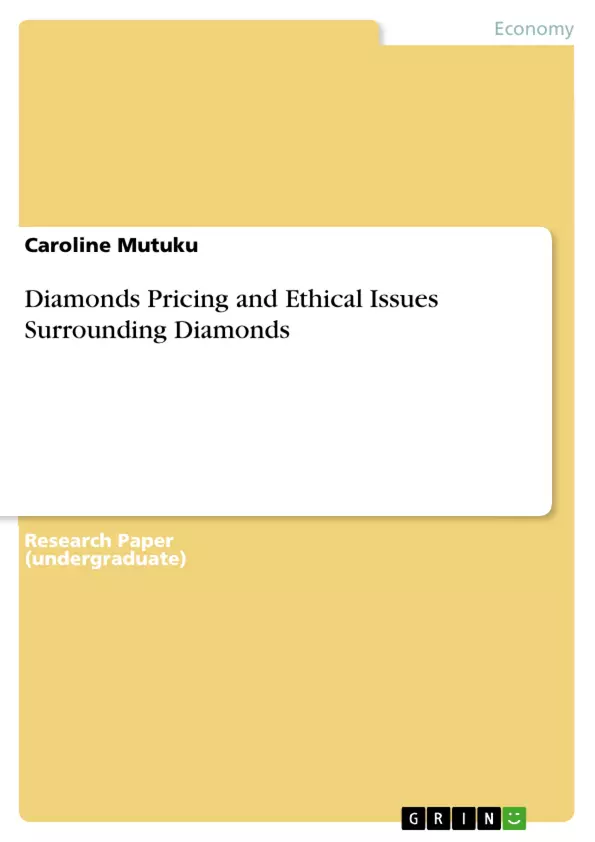Diamonds are believed to be among the most precious commodities for trade. In the past three centuries, diamond has been considered to be one of the rarest mineral elements in the earth’s crust. However, the immense demand for diamond by the global population appears to be the most probable reason as to why diamonds have always been considered as a scarce trade commodity.
Interestingly, geological findings indicate that diamonds top the list of the most abundant gem-quality colored stones. It is argued that diamond pricing is the most outstanding feature which creates unusual demand; thus, making diamonds rare. The second reason why diamonds have been considered to be scarce is the nature of the market structure. Over the years, diamond market has been characterized with an unprecedented monopoly in which a single player existed in the market. As a result, diamond pricing and its supply experienced unique market trends, and this is the principal reason as to why diamond supply chain has been manipulated to create market demand against business ethics.
The De Beers Company has been exercising monopoly since its establishment in 1880s when Cecil Rhodes started diamond trading. Despite the legal barriers including the U.S anti-trust laws, this company has always exercised monopoly in diamond trading. However, monopoly in the diamond market seems to end soon because its supply will increase significantly after Russia joins the market. Recently, a huge diamond field was discovered in Siberia which can supply the world market with trillion of carats in the next thirty centuries. As a result, the structure of the diamond market is believed to change drastically in the future.
Therefore, this research paper will provide an overview of diamond trading, especially with regard to the principal elements of diamond pricing.
Inhaltsverzeichnis (Table of Contents)
- Introduction
- History of Diamond and Diamond Trading
- Return Characteristics of Diamonds
- Current Market Structure
- Diamonds' Characteristics1
- Ethical Issues (Diamond Conflict)
- Valuing Diamonds
- Conclusion
Zielsetzung und Themenschwerpunkte (Objectives and Key Themes)
This research paper aims to provide a comprehensive overview of diamond trading, with a particular focus on the key elements of diamond pricing. It examines the historical context of diamond trading, analyzes the return characteristics of diamonds, and explores the current market structure dominated by De Beers.
- Diamond Pricing and Market Dynamics
- Historical Development of Diamond Trading
- Return Characteristics and Investment Risks
- De Beers' Monopoly and Market Control
- Ethical Issues in the Diamond Industry
Zusammenfassung der Kapitel (Chapter Summaries)
- Introduction: The introduction establishes the context for diamond trading, highlighting its perceived scarcity and the role of diamond pricing in creating demand. It also touches upon the influence of De Beers on diamond market dynamics.
- History of Diamond and Diamond Trading: This chapter traces the historical journey of diamonds from their origins in India to the discovery of major diamond deposits in Brazil and South Africa. It highlights the evolution of diamond trading and the emergence of De Beers as a dominant force in the market.
- Return Characteristics of Diamonds: This chapter explores the unique return characteristics of diamonds, emphasizing their differences from other precious stones. It examines the factors influencing diamond returns, including the history of investment, market structure, and valuation metrics.
- Current Market Structure: This chapter delves into the current market structure of diamond trading, focusing on the historical and present-day dominance of De Beers. It examines the company's influence on diamond marketing and its role in controlling global diamond supply.
Schlüsselwörter (Keywords)
The key terms and concepts explored in this research paper include diamond pricing, diamond trading, return characteristics, market structure, monopoly, De Beers, ethical issues, and diamond conflict.
- Citar trabajo
- Caroline Mutuku (Autor), 2018, Diamonds Pricing and Ethical Issues Surrounding Diamonds, Múnich, GRIN Verlag, https://www.grin.com/document/429851



